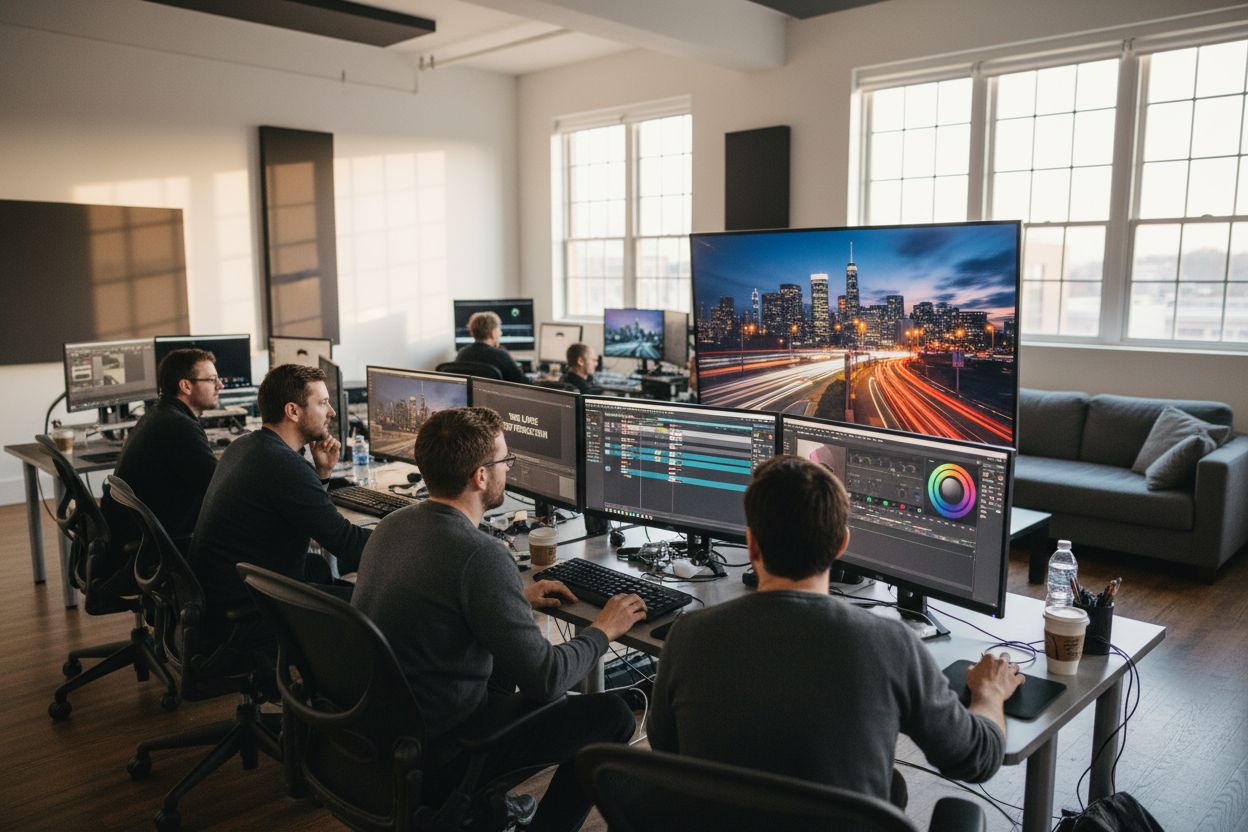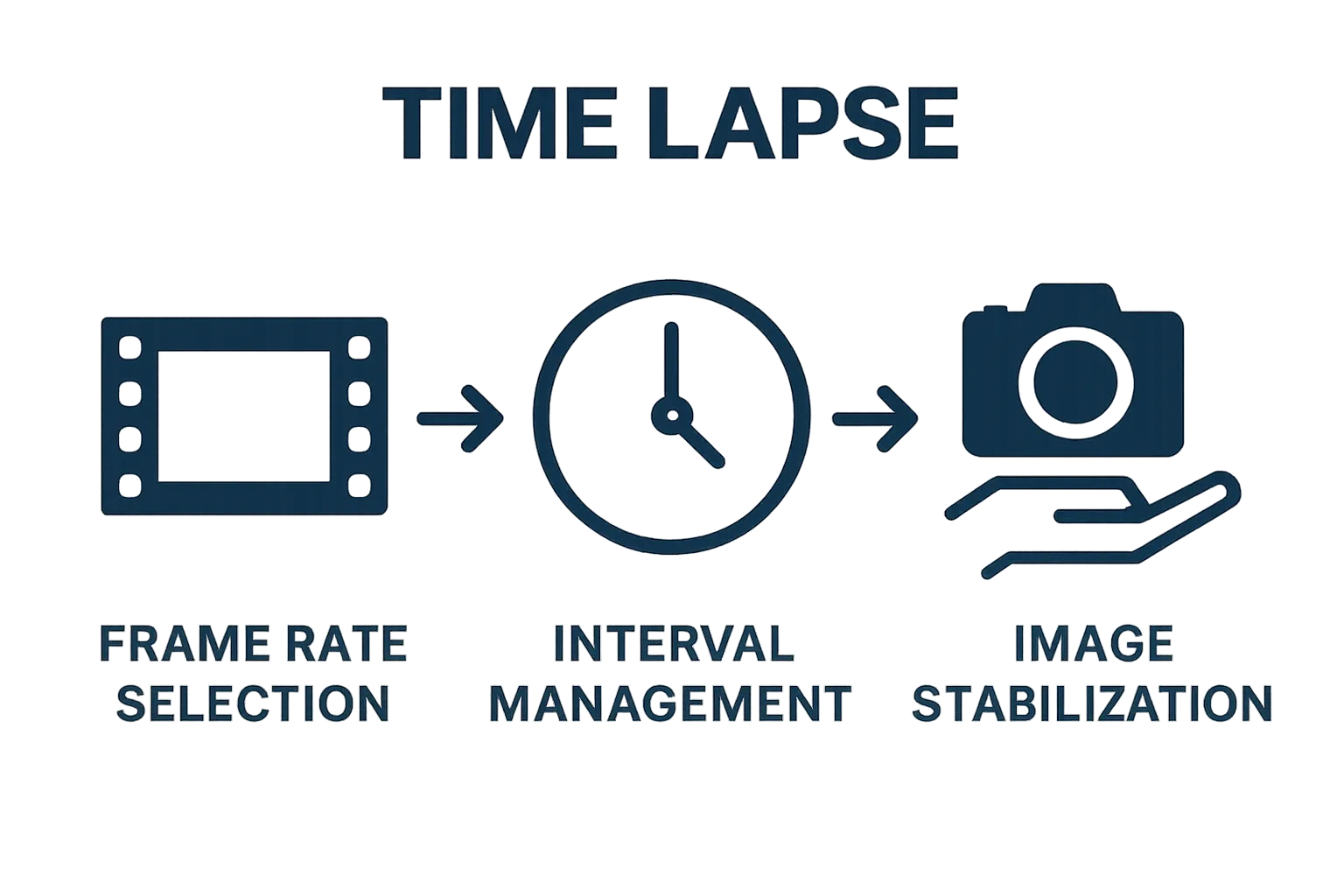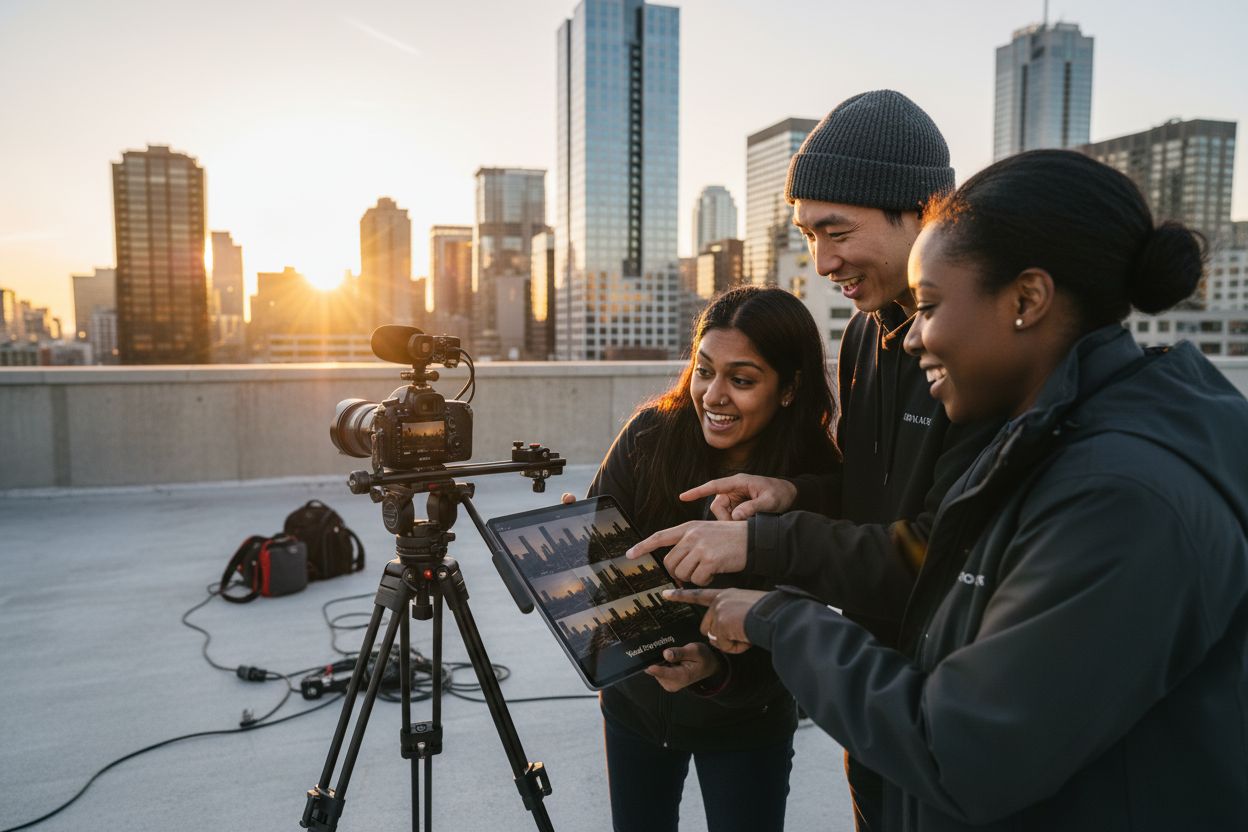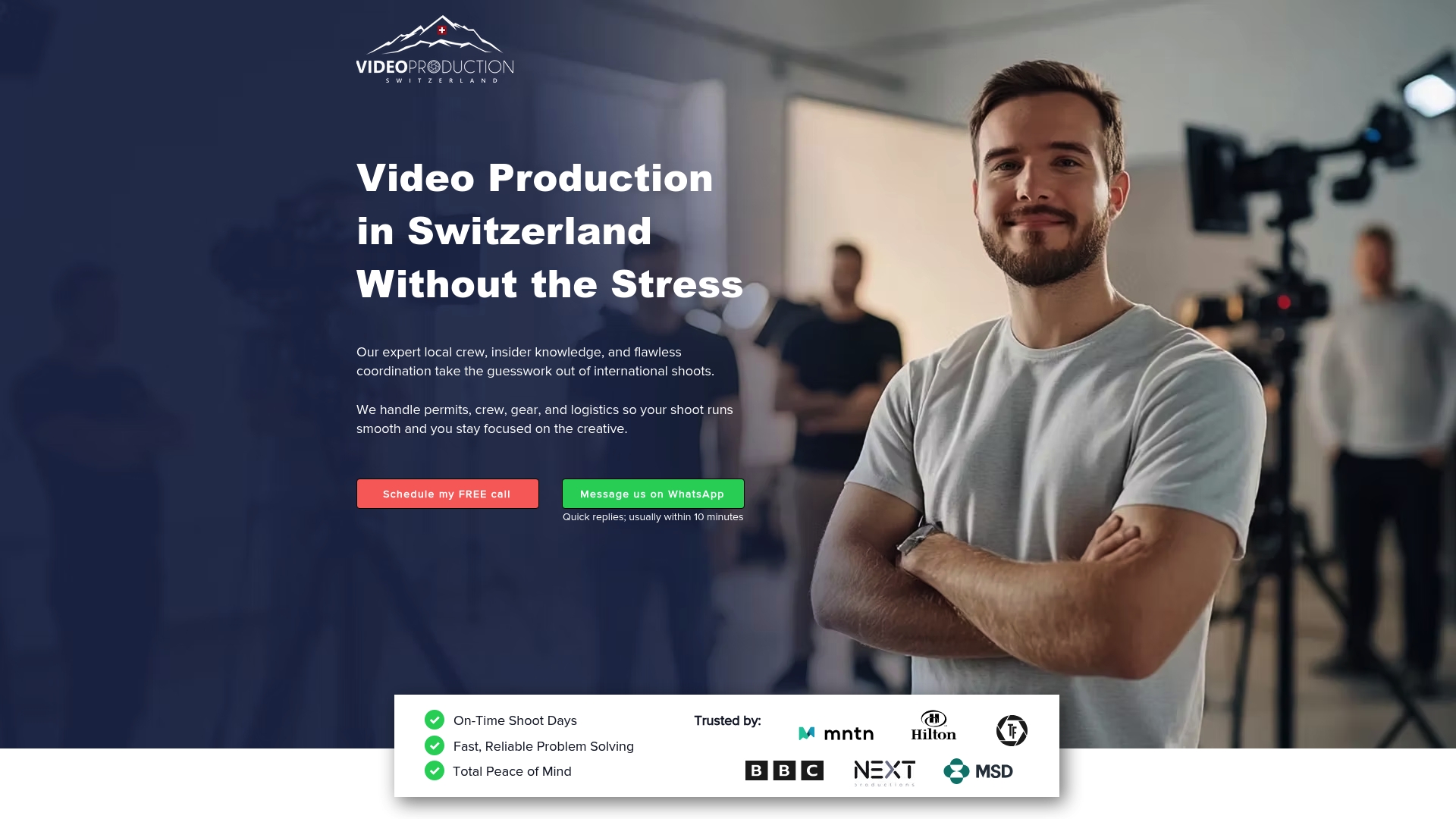Understanding Time Lapse Post Production Techniques
- info1419758
- Oct 4
- 7 min read

Time lapse post production unlocks a way to watch days or even years pass by in just seconds. Think about this. A professional time lapse can condense a full year’s construction process into under two minutes of footage. Most would guess it is all about flashing lights and speed. Actually, the real impact comes from the story hidden in those rapid changes, showing patterns and flows that our eyes usually miss.
Table of Contents
Quick Summary
Takeaway | Explanation |
Time lapse transforms standard footage | This technique accelerates narratives to reveal changes invisible to the eye over time. |
Technical skills are crucial | Filmmakers must carefully manage frame rates, intervals, and stabilization for effective results. |
Emotionally engaging storytelling | Compressed timeframes evoke feelings of wonder and urgency, enhancing viewer connection. |
Wide applications across media | Time lapse can document everything from construction to ecological changes, diversifying visual communication. |
Complex processes made accessible | This technique translates intricate scientific concepts into easily understood visual stories. |
What is Time Lapse Post Production and Its Purpose?
Time lapse post production represents a sophisticated visual storytelling technique that transforms standard video footage into a compressed, accelerated narrative. By manipulating raw captured images, professionals can create stunning sequences that reveal changes and progressions normally imperceptible to the human eye.
The Fundamental Concept of Time Lapse
At its core, time lapse post production involves capturing images at predetermined intervals and then combining these frames into a seamless video sequence. This technique allows viewers to witness gradual transformations that would typically occur over hours, days, or even years, condensed into mere seconds or minutes. Whether documenting natural phenomena like cloud movements, urban development, or intricate manufacturing processes, time lapse provides a unique visual perspective.
Technical Mechanics and Creative Possibilities
The process requires meticulous planning and advanced technical skills. Filmmakers must carefully select capture intervals, consider lighting conditions, and utilize specialized software for frame compilation. Professionals use tools like Adobe After Effects to stabilize footage, adjust color grading, and create smooth transitions between frames.
Key technical considerations for time lapse post production include:
Consistent frame rate selection
Precise interval management
Advanced image stabilization techniques
Color and exposure normalization
Seamless sequence rendering
By understanding these technical nuances, creators can transform ordinary footage into extraordinary visual narratives that compress time and reveal hidden patterns.
Below is a table outlining the key technical considerations and corresponding creative possibilities for time lapse post production, as discussed throughout the article.
Technical Consideration | Description | Creative Possibility |
Frame Rate Selection | Choosing how many frames per second/minute to capture | Controls speed and smoothness of final sequence |
Interval Management | Setting the time gap between each captured image | Reveals subtle or dramatic temporal changes |
Image Stabilization | Correcting camera shake and maintaining consistent framing | Produces visually smooth and professional footage |
Color and Exposure Normalization | Adjusting color tones and brightness across all frames | Delivers cohesive and aesthetically pleasing look |
Sequence Rendering | Combining frames into a seamless time lapse video | Enables storytelling from raw images efficiently |
The Importance of Time Lapse Post Production in Visual Storytelling
Time lapse post production transcends traditional videography by offering a profound method of visual narrative compression that reveals hidden patterns and transformative processes invisible to the naked eye. This technique empowers storytellers to communicate complex temporal experiences through dramatically condensed visual sequences.
Revealing Invisible Temporal Dynamics
Visual storytellers leverage time lapse techniques to expose subtle changes that occur beyond human perception. By strategically manipulating frame rates and intervals, filmmakers can transform seemingly static environments into dynamic landscapes of continuous transformation. From architectural construction projects to natural ecological shifts, time lapse post production provides unprecedented insights into gradual yet significant changes.
Narrative and Emotional Impact
Beyond technical precision, time lapse post production carries profound emotional and narrative potential. By compressing extended timeframes into concise visual experiences, creators can evoke a sense of wonder, urgency, and interconnectedness. According to National Geographic’s visual storytelling research, these techniques generate powerful emotional responses by revealing the often unnoticed rhythms and movements of our world.
Key storytelling advantages include:
Revealing complex processes in accessible formats
Generating emotional engagement through compressed narratives
Demonstrating large scale transformations succinctly
Providing scientific and artistic insights simultaneously
Creating visually compelling content across multiple genres
The method’s versatility extends across numerous domains, from documentary filmmaking to scientific visualization. Explore our comprehensive guide on video production stages to understand how time lapse techniques integrate into broader visual storytelling strategies.
Technical Concepts Behind Time Lapse Post Production
Time lapse post production involves complex technical processes that transform raw captured frames into compelling visual narratives. Professionals must navigate sophisticated computational and creative techniques to achieve seamless temporal compression and visual coherence.
Frame Rate and Interval Dynamics
The fundamental technical framework of time lapse post production centers on strategic frame capture and processing. Filmmakers must meticulously calculate capture intervals, considering factors like subject movement, environmental conditions, and desired compression ratio. Professional time lapse sequences typically range from 1 frame per second for slow transformations to 1 frame per minute for extended geological or botanical processes.

Image Processing and Stabilization Techniques
Advanced computational methods play a crucial role in refining time lapse footage. According to B&H Photo Video’s professional guide, critical technical considerations include:
Exposure ramping to manage changing light conditions
Digital image stabilization to eliminate camera shake
Noise reduction algorithms for consistent visual quality
Advanced color grading for maintaining visual consistency
Frame interpolation for smoother motion transitions
These sophisticated techniques require specialized software like Adobe After Effects, Lightroom, and dedicated time lapse processing applications. Professionals must balance technical precision with creative vision to produce compelling visual narratives that compress extended temporal experiences into concise, engaging sequences. Learn more about our comprehensive video production workflow to understand how these technical processes integrate into broader creative strategies.
Creative Applications of Time Lapse Post Production in Media
Time lapse post production has emerged as a transformative storytelling technique across diverse media disciplines, offering unprecedented visual communication strategies that compress complex temporal experiences into engaging, accessible narratives.
Documentary and Scientific Visualization
In documentary filmmaking and scientific communication, time lapse techniques provide extraordinary insights into processes typically imperceptible to human observation. Researchers and filmmakers utilize these methods to reveal intricate transformations in natural ecosystems, astronomical phenomena, and biological systems. From documenting glacial movements to tracking cellular regeneration, time lapse post production bridges the gap between scientific complexity and public understanding.

Architectural and Urban Documentation
Architects and urban planners leverage time lapse post production to capture the dynamic evolution of architectural projects and urban landscapes. According to Architectural Digest’s visual documentation research, these techniques offer powerful narratives of construction processes, urban development, and environmental changes.
Key creative applications across media domains include:
This table provides a comparison of primary application areas for time lapse post production, highlighting examples from the article and their distinctive uses.
Application Area | Example Mentioned | Distinctive Use |
Documentary Filmmaking | Ecosystem changes, glacial movements | Reveals natural processes and environmental transformations |
Scientific Visualization | Cellular regeneration, astronomical events | Bridges scientific concepts with accessible public insights |
Architectural Documentation | Construction projects, urban development | Showcases chronological progress of building and city changes |
Marketing | Brand storytelling visuals | Creates eye-catching content for engagement |
Education | Process demonstrations, science lessons | Helps visualize complex information in a simple format |
Artistic Expression | Experimental sequences | Allows creative exploration of patterns and movements |
Revealing complex scientific processes
Documenting long term environmental transformations
Creating compelling visual narratives for marketing
Illustrating technological and infrastructure development
Providing immersive storytelling experiences
Beyond traditional applications, time lapse techniques have expanded into innovative domains like brand storytelling, educational content, and artistic expression. Explore our comprehensive guide on global media production strategies to understand how these visual techniques are revolutionizing media communication.
Unlock Seamless Time Lapse Productions in Switzerland
Have you ever struggled to bring your time lapse vision to life because of overwhelming logistics, unreliable equipment, or the challenge of coordinating expert local crews? The article highlighted the technical precision required in time lapse post production and the frustration when these skills are let down by practical obstacles. If capturing world-class visual storytelling is your goal, you need a partner who not only understands the creative process but also ensures every detail behind the scenes runs perfectly—lighting, permits, and timing included.

Choose Video Production Switzerland and enjoy true peace of mind. Our dedicated team specializes in removing hassles for international filmmakers. We handle everything from finding the right crew to sourcing reliable gear. Start with a free consultation to discuss your project and learn how we streamline the entire process. Need a comprehensive workflow? Explore our video post production guide. If you want your time lapse footage to reflect true expertise and get delivered on time, now is the moment to connect with your trusted partner for video production success in Switzerland.
Frequently Asked Questions
What is time lapse post production?
Time lapse post production is a technique that transforms standard video footage into an accelerated visual narrative by capturing images at predetermined intervals and combining them into a cohesive sequence.
How does time lapse post production reveal hidden changes?
By compressing long periods of time into short video segments, time lapse allows viewers to observe gradual transformations in various subjects, such as natural phenomena or architectural developments, that would typically go unnoticed.
What technical skills are essential for time lapse post production?
Essential skills include calculating frame capture intervals, managing lighting conditions, image stabilization, color grading, and proficiency with software such as Adobe After Effects for editing and processing the footage.
In what fields is time lapse post production commonly used?
Time lapse post production is widely used in documentary filmmaking, scientific visualization, architectural documentation, urban planning, and even in marketing to create compelling visual narratives that engage viewers.
Recommended

Comments